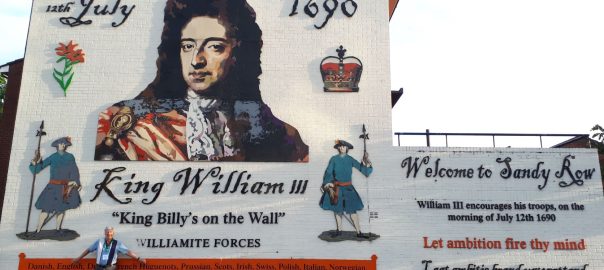Happy Orangeman’s Day — or not.
July 12th is a holiday in Northern Ireland, commemorating the victory of Protestant William of Orange over Britain’s Catholic King James II at the Battle of the Boyne in 1690. Ulster Protestants celebrate the day with marching band parades; Catholics escape the noise and traffic snarls to beaches in the southern Republic of Ireland.
A month ago, my husband Will and I took a bus tour through Belfast, Northern Ireland. Union Jack Flags, red, white and blue banners, and posters of Queen Elizabeth II decorated homes and businesses in Protestant neighbourhoods in celebration of her majesty’s recent Jubilee weekend. Our tour guide said people would leave the decorations up another month for Orangeman’s Day. The splashy displays ceased abruptly when we crossed into Catholic neighbourhoods.
During The Troubles in Northern Ireland from the late 1960s to late 1990s, Orangeman’s Day was often marked by riots and violence. Protestants would provoke conflict by marching into Catholic neighbourhoods. During that thirty year ‘irregular war’ that killed more than 3,500 people, I wouldn’t have considered a holiday in Belfast, but I didn’t give it a thought this year. We stayed in the Europa Hotel, which experienced 36 bomb attacks during The Troubles and was called the most bombed hotel in the world. Since then, the renovated hotel has gone high tech with ‘smart’ elevators and window blinds.

Our tour bus stopped at the peace wall that divides the predominantly republican, nationalist, Catholic Falls Road area from the loyalist, unionist, Protestant Shankhill Road area of West Belfast. These peace lines are supposed to be removed by 2023, but they’ve become popular tourist attractions. Former IRA members conduct black taxi tours of the walls, complete with their versions of The Troubles and the current political situation. I found this image an unsettling reminder that the conflict isn’t over.

This was brought home to me even more in Londonderry or Derry, depending on your political view. Ireland’s second largest city is located close to the Irish border and is about 75% Catholic (Belfast is roughly 49% Catholic). A local guide gave us a tour of the Derry walls, built in the 1600s as a defense against Catholic attacks. He said that during The Troubles Catholics, who lived largely across the river, weren’t allowed into the city gates. It’s hard to believe this is recent history.


Since the Catholic and Protestant neighbourhoods rise up from the river banks the city’s political divide is visible. Recently there has been some merging. Our guide said he grew up on the boggy Catholic side, but now lives in Protestant (London)Derry. During The Troubles, he knew people who had never ventured to the opposite side of the river. Since 2011, a pedestrian Peace Bridge has connected the two divides. Some suggest the bridge’ s ‘falling-over’ design reflects the shaky peace. Our guide noted that Brexit has refueled the push for a unified Ireland. He pointed out a section of sidewalk damaged by a car bomb, the first since the 1998 Good Friday Agreement that ended The Troubles.

Peace Bridge, Londonderry/Derry
